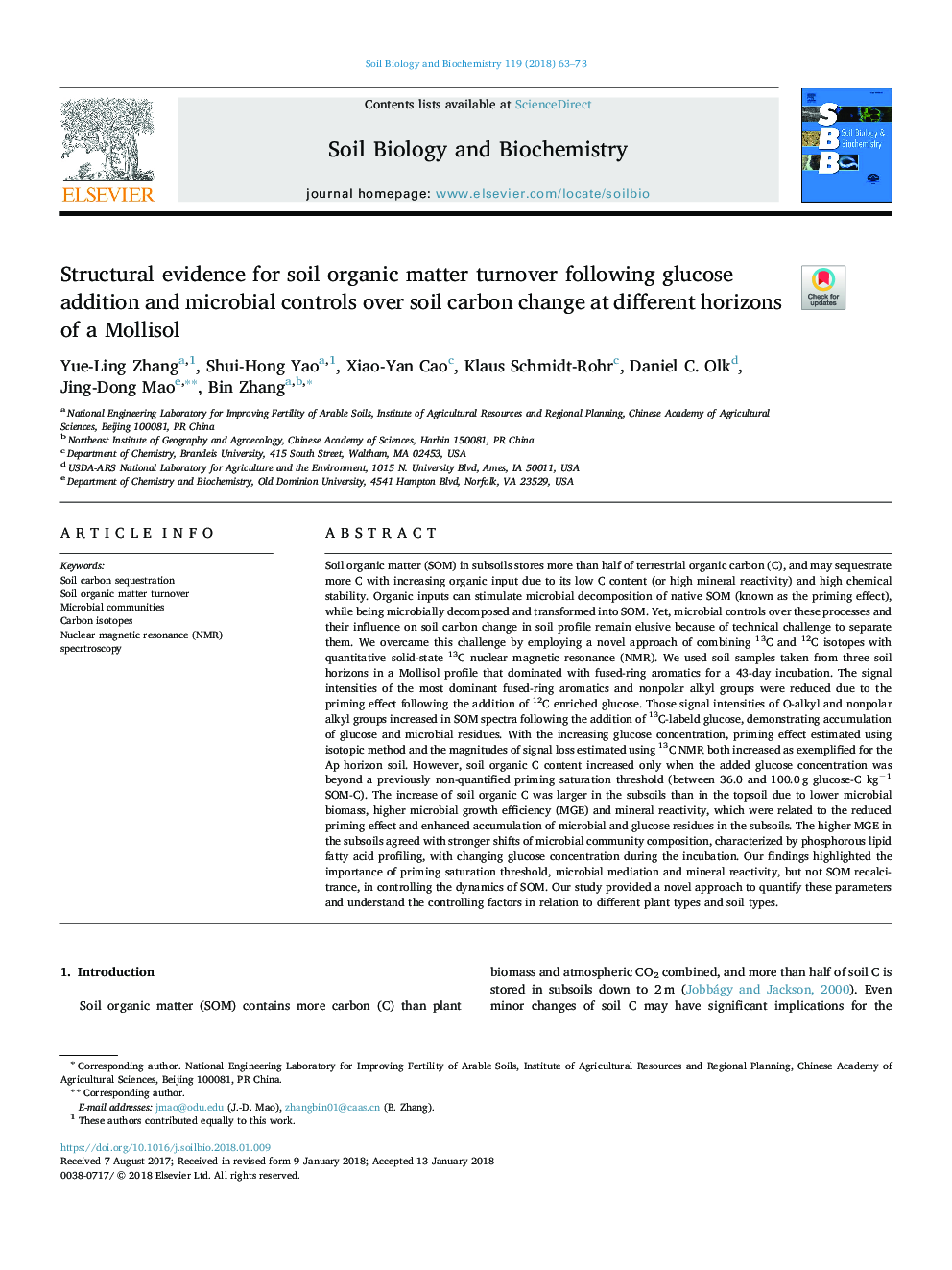| کد مقاله | کد نشریه | سال انتشار | مقاله انگلیسی | نسخه تمام متن |
|---|---|---|---|---|
| 8362881 | 1542565 | 2018 | 11 صفحه PDF | دانلود رایگان |
عنوان انگلیسی مقاله ISI
Structural evidence for soil organic matter turnover following glucose addition and microbial controls over soil carbon change at different horizons of a Mollisol
دانلود مقاله + سفارش ترجمه
دانلود مقاله ISI انگلیسی
رایگان برای ایرانیان
کلمات کلیدی
موضوعات مرتبط
علوم زیستی و بیوفناوری
علوم کشاورزی و بیولوژیک
دانش خاک شناسی
پیش نمایش صفحه اول مقاله

چکیده انگلیسی
Soil organic matter (SOM) in subsoils stores more than half of terrestrial organic carbon (C), and may sequestrate more C with increasing organic input due to its low C content (or high mineral reactivity) and high chemical stability. Organic inputs can stimulate microbial decomposition of native SOM (known as the priming effect), while being microbially decomposed and transformed into SOM. Yet, microbial controls over these processes and their influence on soil carbon change in soil profile remain elusive because of technical challenge to separate them. We overcame this challenge by employing a novel approach of combining 13C and 12C isotopes with quantitative solid-state 13C nuclear magnetic resonance (NMR). We used soil samples taken from three soil horizons in a Mollisol profile that dominated with fused-ring aromatics for a 43-day incubation. The signal intensities of the most dominant fused-ring aromatics and nonpolar alkyl groups were reduced due to the priming effect following the addition of 12C enriched glucose. Those signal intensities of O-alkyl and nonpolar alkyl groups increased in SOM spectra following the addition of 13C-labeld glucose, demonstrating accumulation of glucose and microbial residues. With the increasing glucose concentration, priming effect estimated using isotopic method and the magnitudes of signal loss estimated using 13C NMR both increased as exemplified for the Ap horizon soil. However, soil organic C content increased only when the added glucose concentration was beyond a previously non-quantified priming saturation threshold (between 36.0 and 100.0â¯g glucose-C kgâ1 SOM-C). The increase of soil organic C was larger in the subsoils than in the topsoil due to lower microbial biomass, higher microbial growth efficiency (MGE) and mineral reactivity, which were related to the reduced priming effect and enhanced accumulation of microbial and glucose residues in the subsoils. The higher MGE in the subsoils agreed with stronger shifts of microbial community composition, characterized by phosphorous lipid fatty acid profiling, with changing glucose concentration during the incubation. Our findings highlighted the importance of priming saturation threshold, microbial mediation and mineral reactivity, but not SOM recalcitrance, in controlling the dynamics of SOM. Our study provided a novel approach to quantify these parameters and understand the controlling factors in relation to different plant types and soil types.
ناشر
Database: Elsevier - ScienceDirect (ساینس دایرکت)
Journal: Soil Biology and Biochemistry - Volume 119, April 2018, Pages 63-73
Journal: Soil Biology and Biochemistry - Volume 119, April 2018, Pages 63-73
نویسندگان
Yue-Ling Zhang, Shui-Hong Yao, Xiao-Yan Cao, Klaus Schmidt-Rohr, Daniel C. Olk, Jing-Dong Mao, Bin Zhang,